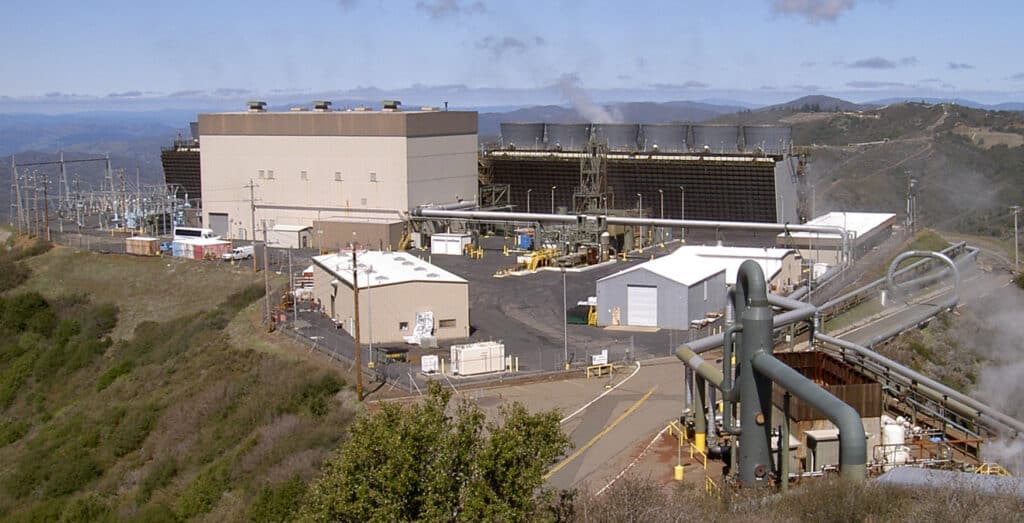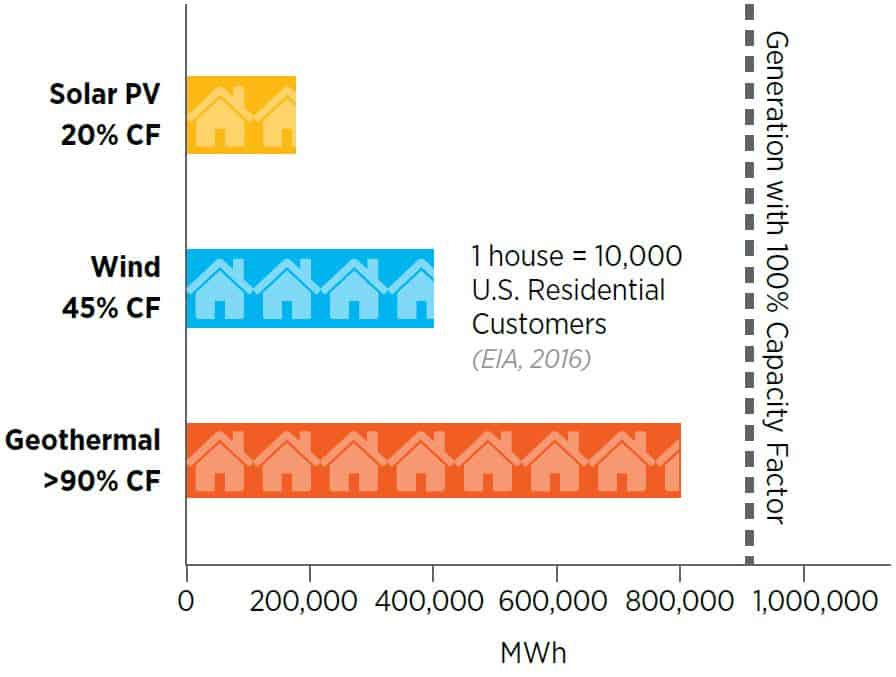Geothermal energy stands out among other energy sources (both renewable and nonrenewable) used for power for a variety of reasons. Some of those benefits are described below.
Renewable
The heat flowing from Earth’s interior is continually replenished by the decay of naturally occurring radioactive elements. Earth’s heat is consistent, infinite, and projected to last for billions of years making geothermal energy a long-lasting source of electricity.
Baseload Power
In contrast to other forms of renewable energy, geothermal does not depend on the time of day or weather conditions. Geothermal power plants produce electricity consistently and can run essentially 24 hours per day/7 days per week, regardless of weather conditions, and can therefore act as baseload power. Baseload power refers to an energy system that can produce electricity consistently. For example, at the moment, wind and solar power are not considered baseload energy systems because they rely on weather conditions to produce energy. Examples of baseload power production include nuclear power plants, gas-fired power plants, coal-fired power plants, and run-of-river power plants (operated on a river). Geothermal power plants produce electricity consistently and can run essentially 24 hours per day/7 days per week, regardless of weather conditions.

Domestic
U.S. geothermal resources can be harnessed for power production without importing fuel. The domestic nature of this energy resource makes the United States less dependent on other nations and long-range transport for our energy needs.
Small Surface Footprint
Geothermal power plants are compact, have a low profile and use less land per gigawatt-hour than comparable-capacity coal, wind, and solar photovoltaic (PV) power stations.2Office of Energy Effiency & Renewable Energy. (n.d.) Geothermal Basics. https://www.energy.gov/eere/geothermal/geothermal-basics.
Clean
Geothermal plants do not require transport, storage, or combustion of a fossil fuel to produce electricity, and thus, have a low carbon footprint.3Office of Energy Efficiency & Renewable Energy. (n.d.) Geothermal FAQs. https://www.energy.gov/eere/geothermal/geothermal-faqs Geothermal power plants consume less water on average over the lifetime energy output than most conventional electricity-generation technologies.4 Office of Energy Effiency & Renewable Energy. (n.d.) Geothermal Basics. https://www.energy.gov/eere/geothermal/geothermal-basics.
Helpful Vocabulary
Capacity factor: A unitless ratio, capacity factor, describes the actual electrical energy output over a given period of time compared to the maximum possible electrical energy output over the same amount of time. For example, a capacity factor of .50 would describe an energy output that is half of the rated output over a set period of time.
Nameplate capacity: The rated capacity, or nameplate capacity, is the intended full-load sustained output of a power station.
High Capacity Factor
The high (>90%) capacity factor of geothermal energy allows geothermal power plants to operate around-the-clock, with steady output nearly all of the time. A geothermal plant will generate 2-4 times as much electricity as a wind or solar plant of the same installed capacity due to its high capacity factor.

For example, a 100-MWe solar photovoltaic facility would generate electricity for fewer than 16,300 households (less than 200,000 megawatt-hours-electric [MWhe]), whereas a wind energy project of the same capacity could generate electricity for around 37,000 households (about 400,000 MWhe). By comparison, a geothermal power plant with the same nameplate capacity would produce enough electricity to power more than 74,000 households (about 800,000 MWhe).6U.S. Dept. of Energy. (2019, May). GeoVision: Harnessing the Heat Beneath Our Feet. https://www.energy.gov/eere/geothermal/articles/geovision-full-report-0.7 Cole, W., Kurup, P., Hand, M., Feldman, D., Sigrin, B., Lantz, E., Stehly, T., Augustine, C., Turchi, C., O’Connor, P., & Waldoch, C. (2016). 2016 Annual Technology Baseline (ATB). NREL/PR-6A20-66944. Golden, CO. National Renewable Energy Laboratory. Accessed July 3, 2023. https://www.osti.gov/servlets/purl/1320377
What is a typical value for geothermal gradient?
Incorrect
Correct
Incorrect
How does geothermal not stand out among other types of power production?
Incorrect
Incorrect
Correct
Incorrect
Image Credits
- Sonoma_Plant_at_The_Geysers_4778: Stepheng3 via Wikipedia
- Geothermal-capacity-factor-GeoVision-2.14: DOE, GeoVision, data sourced EIA